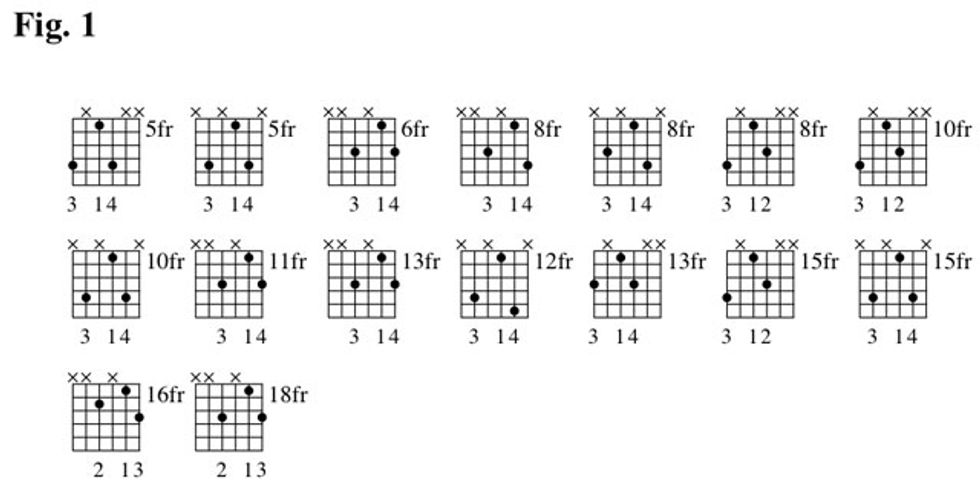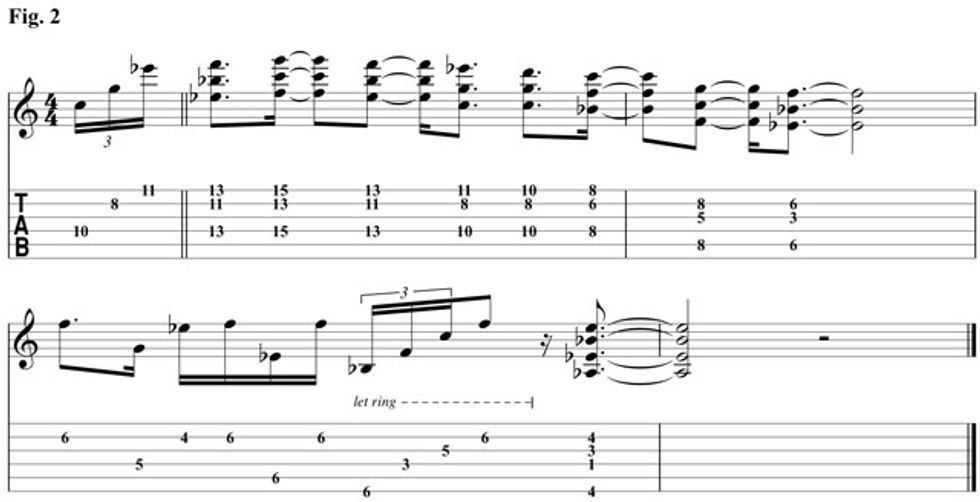Learn how to create three-note pentatonic chords all over the neck.
Chops: Intermediate
Theory: Advanced Beginner
Lesson Overview:
• Learn how to create three-note pentatonic chords all over the neck.
• Combine chords and single-note lines to create flowing phrases.
• Develop intervallic lines that connect different pentatonic shapes.
Click here to download a printable PDF of this lesson's notation.
This month I feel like changing it up a bit. The past two lessons have focused on shred licks and pentatonic ideas, but for this lesson I want to dive into some chord voicings. The voicings I’m about to unleash on you are pretty cool because they are really simple, but very effective. I like to look at these chords using a pattern-based system, rather than identifying what the actual chords are. Although it’s good to take a second and learn how the notes function within each chord, my approach here is more of using them as passing chords or ear candy within a certain key center.
In the first example (Fig. 1) I want to show you all the voicings up the neck so you can come up with your own chordal licks and have a strong handle on the visualization of the chords. We are in the key of C minor, and the basic makeup of these chords come straight out of C minor pentatonic (C–Eb–F–G–Bb), using fifths or sometimes the occasional sixth to remain diatonic. Make sure to also experiment with single-note phrases along with these shapes to come up with some really cool ideas.

In Fig. 2, I have incorporated some single-note lines just to give you an idea of how to get the most out of these voicings. These are reminiscent of Eric Johnson’s chord work because of the open fifths and sixths, and the fact that the harmony all moves through the pentatonic scale. The thing I like most about these color chords is that you can use them to solo with and as a vehicle to move around the neck. The sound also reminds me a bit of Wes Montgomery, who in my opinion, was the king of chord solos, but that isn’t quite the sound we are looking for. This is more of a rock or pop—or maybe even country—sound than jazz. That said, you should keep an open mind and apply the ideas wherever you can.

Fig. 3 is simply a single-note line that uses these shapes to climb up the neck. At times, this technique can sound like some of the intervallic phrases Carl Verheyen plays. My strategy for this lick is to use the middle voice in the shape for position changes in the first half of the lick, and then the top voice for the second half. I recommend doing this to break up the phrase so it doesn’t sound like you’re playing a pattern.

The real goal of this lesson is to give you some new shapes and a few examples of how to use them to create your own ideas. I incorporate these concepts in my playing because, more than just learning a lick, they help you create your own vocabulary and allow you to connect more areas of the fretboard.
 Since graduating from Musician's Institute in 2004, Justin Derrico has toured with artists such as The Calling and Robin Thicke, and also performed with Tina Turner and Beyonce at the Grammys. He is currently touring with Pink as well as playing in the house band for NBC's hit show, The Voice. For more information, visit justinderrico.com.
Since graduating from Musician's Institute in 2004, Justin Derrico has toured with artists such as The Calling and Robin Thicke, and also performed with Tina Turner and Beyonce at the Grammys. He is currently touring with Pink as well as playing in the house band for NBC's hit show, The Voice. For more information, visit justinderrico.com.